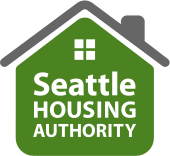SEATTLE—August 13, 2003—A crowd of Rainier Vistaresidents, employees and friends of Providence Health System, City employees and Seattle Housing Authority Board and staff gathered on August 13 to mark the official beginning to the construction of the new Rainier Vista, a 1,010-unit mixed-income Rainier Vista housing development in the Rainier Valley.
Accompanied by lilting jazz provided by Triology, the crowd of over 300 well-wishers enjoyed snacks from four local restaurants featuring cuisine of varied cultures. When a group of about ten local activists from the Labor Employment Law Office arrived with banners and bull horns, they were invited to join the celebration and provided with time at the end of the program to address the crowd regarding the need for jobs for local residents.
The project will provide housing to residents with a range of incomes, including the elderly and those with disabilities. It will include a new home for Providence ElderPlace, a program that serves nursing home-eligible seniors. There will also be homes built for sale to the general public, in addition to workforce housing units.
The groundbreaking celebration took place on the construction site. It included special guest Seattle Mayor Greg Nickels; Seattle City Council President Peter Steinbrueck; Rainier Vista Leadership Team member and resident Hoa Dieu; Greg Van Pelt, Vice President and Chief Executive of Providence Health System; HUD Regional Administrator John Meyers; and Seattle Housing Authority Executive Director Harry Thomas.
Planning for the redevelopment at Rainier Vista began over five years ago. Then, after receiving a $35 million grant from the U.S. Department of Housing and Urban Development (HUD) in 1999, the Seattle Housing Authority began working closely with residents and community groups to refine the plans and begin the process of relocating Rainier Vista residents.
Demolition began on the site in late 2002, after the Housing Authority reached a settlement agreement with advocates who brought suit to require that every low-income housing unit originally existing on the site be replaced there. The Housing Authority agreed to replace all but 71 of the original 481 units on site. The remainder will be replaced elsewhere in Seattle.
The project will be completed in two phases, with Phase I consisting of the area west of Martin Luther King, Jr. Way. Phase I will include the following:
- 184 apartments for low-income residents with incomes below 60 percent of the area median income (AMI). Of these, 140 units will receive HUD subsidy and serve households with incomes below 30 percent of AMI. Once the current grading and infrastructure work is complete, construction will start on in early 2004, with completion expected in early 2005.
- Gamelin House, a project of Providence Health System will include 78 apartments for low-income elderly, also targeted to residents with incomes below 30 percent of AMI. These apartments will be built through a HUD program (Section 202), which subsidizes housing for the elderly. It will also be the new site of Providence ElderPlace, a program currently located at 5900 Martin Luther King, Jr. Way that serves nursing-home-eligible seniors. Construction will begin in late fall.
- Genesee House, a 50-unit apartment house being built by Housing Resources Group in partnership with AIDS Housing of Washington. Within this building, 22 apartments will serve residents with physical disabilities. Construction on Genesee House will begin in January 2004.
- Neighborhood House will develop a new facility with approximately 10,000 square feet of space for Head Start, classrooms, social services and community space. Construction on this facility will begin in January 2004.
- Approximately 200 building lots will be sold to private housing developers who will construct homes that will be sold to the general public.
When the redevelopment began, all of the residents living in Rainier Vista received individual counseling to assist them with relocation. Prior to demolition, 99 households moved from the west side of Martin Luther King, Jr. Way to apartments on the east side.
Some residents moved offsite to other housing: 57 households moved to other SHA housing and 87 moved to non-SHA housing. Four families have also become home owners.
100 households chose to move off site using a Housing Choice Voucher, which provides rent subsidy in the private sector. Ninety-five households stayed in their original housing on the east side of Martin Luther King, Jr. Way and will move into the new housing on the west side when it is completed.
